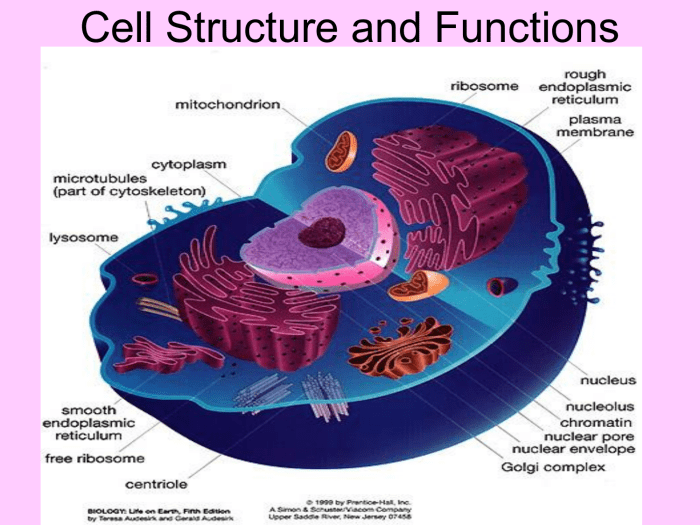Embark on an academic exploration with our comprehensive Study Guide for Cell Structure and Function. Delve into the intricate world of cells, their fundamental components, and their vital roles in sustaining life.
This guide unveils the structural marvels of eukaryotic cells, from the nucleus to the organelles, and elucidates the functions that each component plays in the harmonious operation of the cell.
Cell Structure: Study Guide For Cell Structure And Function

Eukaryotic cells are the basic unit of life and are composed of various components that work together to perform specific functions. These components include the nucleus, cytoplasm, and organelles. The nucleus houses the cell’s genetic material, while the cytoplasm contains the cell’s organelles and other structures.
Organelles are specialized structures that carry out specific functions, such as the mitochondria, which produce energy, and the endoplasmic reticulum, which is involved in protein synthesis.
Cell Types
| Cell Type | Structure | Function |
|---|---|---|
| Plant Cell | Cell wall, chloroplasts, large vacuole | Provides structural support, photosynthesis, storage |
| Animal Cell | No cell wall, smaller vacuoles | Mobility, cell signaling, muscle contraction |
| Prokaryotic Cell | No nucleus, no membrane-bound organelles | Simple structure, found in bacteria |
| Eukaryotic Cell | Nucleus, membrane-bound organelles | Complex structure, found in plants, animals, fungi, and protists |
Cell Function

Cells carry out essential metabolic processes to maintain their structure and function. Glycolysis, the Krebs cycle, and oxidative phosphorylation are key processes involved in energy production. The cell membrane regulates the movement of substances into and out of the cell, ensuring the cell’s internal environment is maintained.
Cells also use energy to perform specific tasks, such as muscle contraction and nerve impulse transmission.
Cell Metabolism
- Glycolysis: Breaks down glucose to produce energy (ATP)
- Krebs Cycle: Oxidizes acetyl-CoA to produce energy (ATP)
- Oxidative Phosphorylation: Uses oxygen to produce a large amount of energy (ATP)
Cell Division
Cell division is essential for growth, repair, and reproduction. Mitosis and meiosis are two main types of cell division. Mitosis produces two identical daughter cells, while meiosis produces four genetically diverse daughter cells.
Stages of Mitosis
- Prophase: Chromosomes condense
- Metaphase: Chromosomes align at the cell’s equator
- Anaphase: Chromosomes separate and move to opposite poles
- Telophase: Nuclear membranes form around each set of chromosomes
Cell Communication
Cells communicate with each other to coordinate their activities and maintain homeostasis. Paracrine, endocrine, and autocrine signaling are different types of cell signaling. Cells use receptors to receive and respond to signals from other cells.
Types of Cell Signaling, Study guide for cell structure and function
- Paracrine Signaling: Signals act on nearby cells
- Endocrine Signaling: Signals travel through the bloodstream
- Autocrine Signaling: Signals act on the same cell that released them
FAQ Compilation
What is the primary function of the cell membrane?
Regulating the movement of substances into and out of the cell
What are the key stages of mitosis?
Prophase, metaphase, anaphase, and telophase
How do cells use energy to perform specific tasks?
Through processes such as muscle contraction or nerve impulse transmission